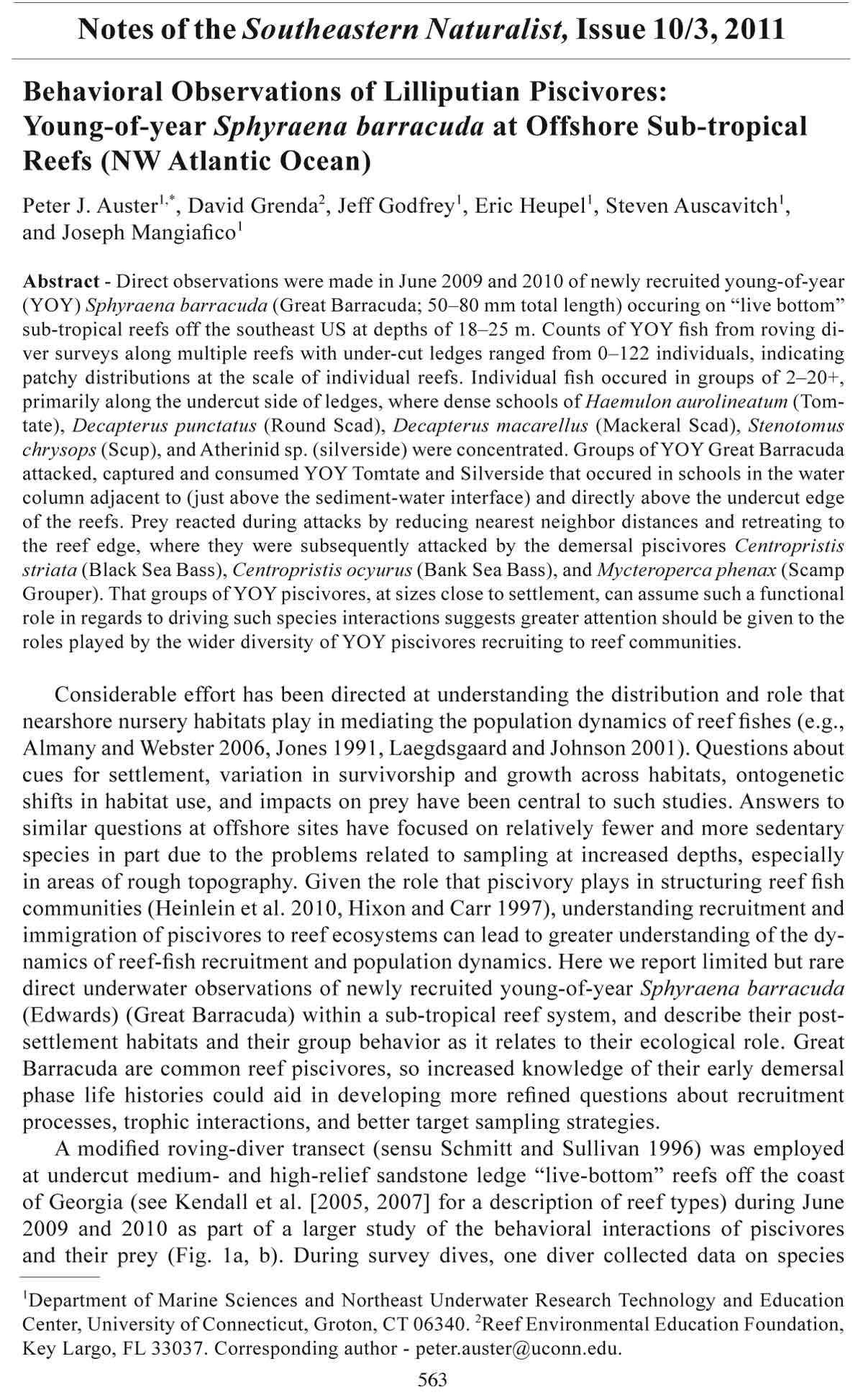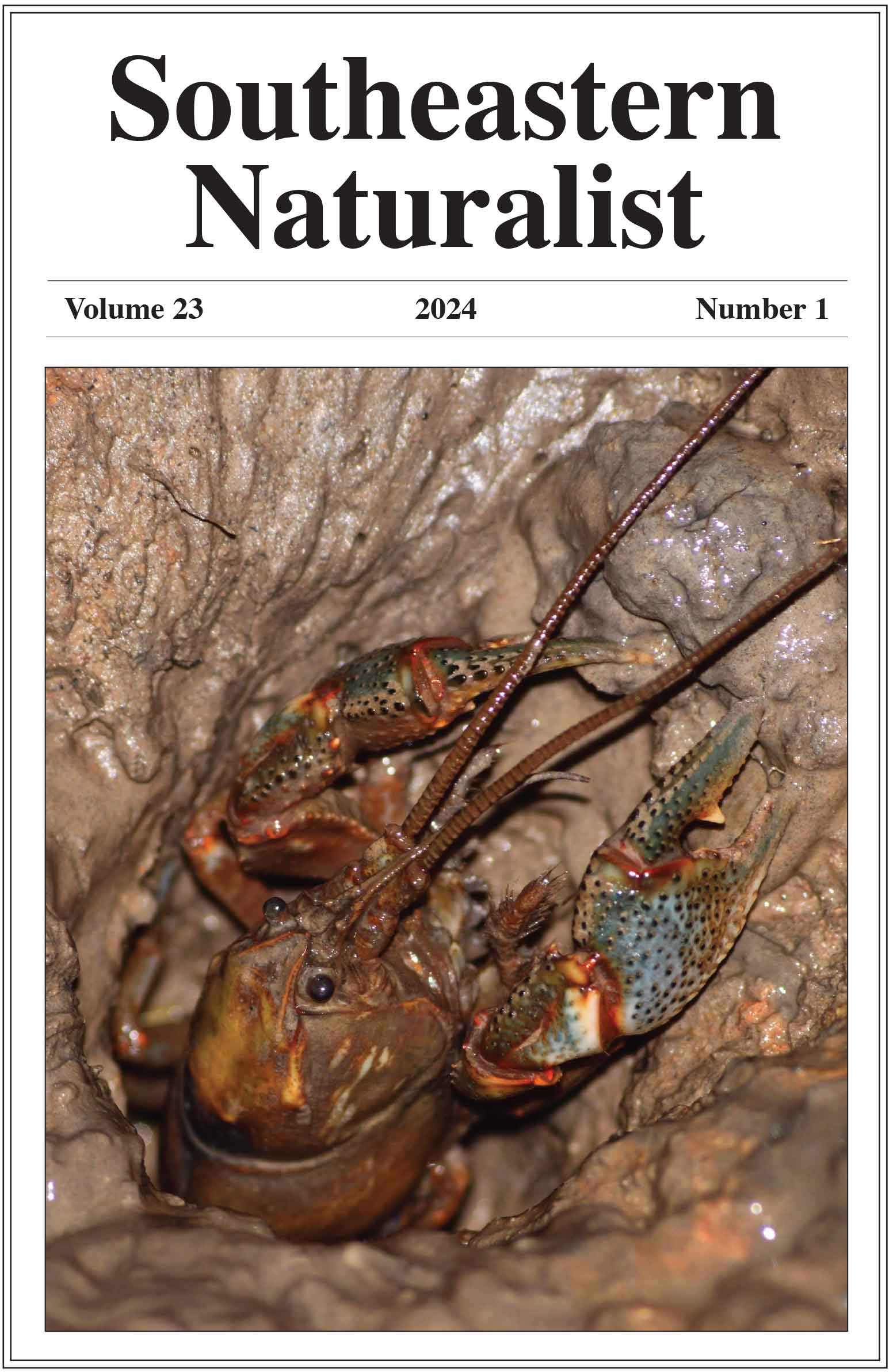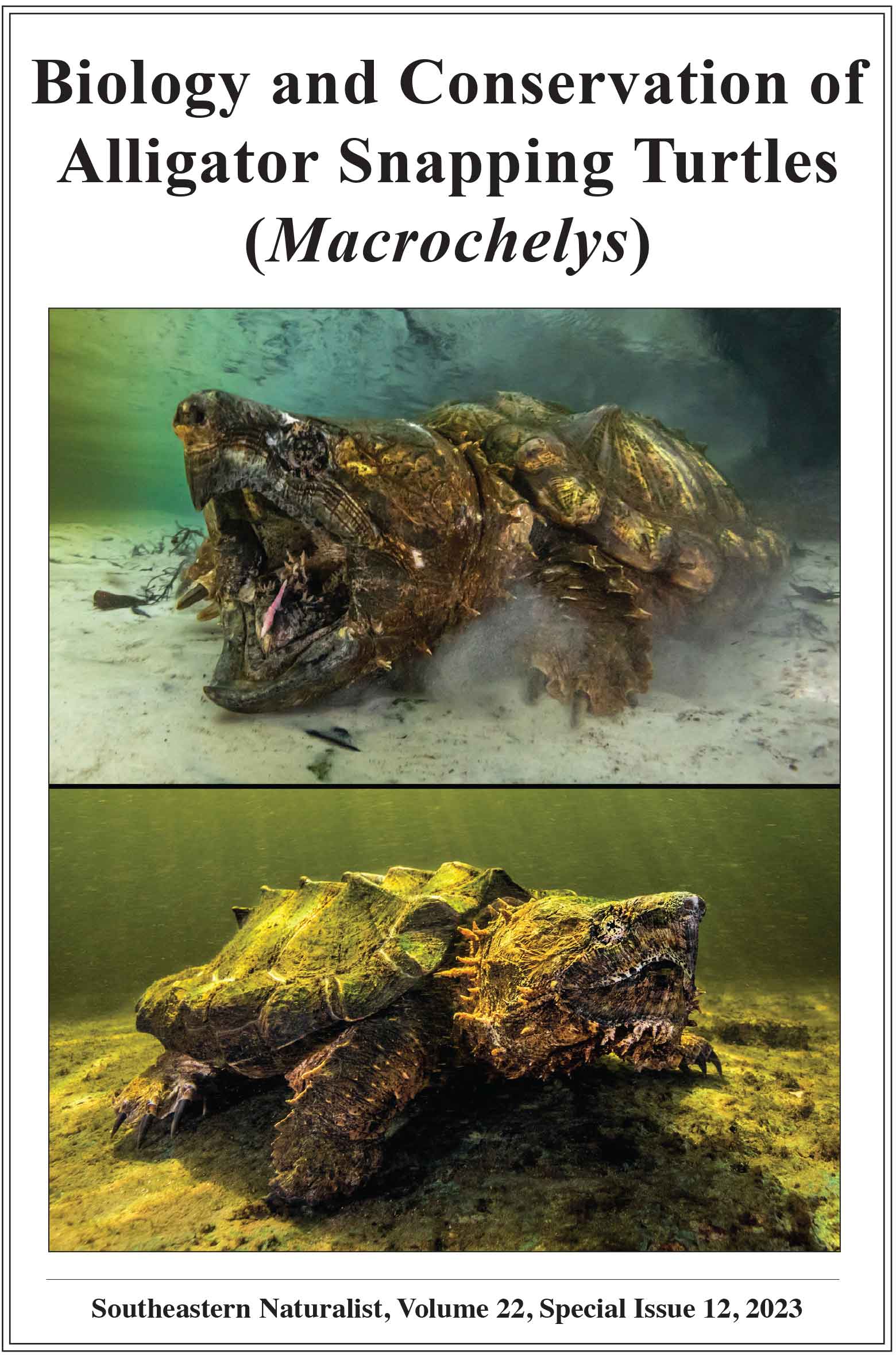Behavioral Observations of Lilliputian Piscivores:
Young-of-year Sphyraena barracuda at Offshore Sub-tropical
Reefs (NW Atlantic Ocean)
Peter J. Auster, David Grenda, Jeff Godfrey, Eric Heupel, Steven Auscavitch,
and Joseph Mangiafico
Southeastern Naturalist, Volume 10, Issue 3 (2011): 563–569
Full-text pdf (Accessible only to subscribers.To subscribe click here.)

Behavioral Observations of Lilliputian Piscivores:
Young-of-year Sphyraena barracuda at Offshore Sub-tropical
Reefs (NW Atlantic Ocean)
Peter J. Auster1,*, David Grenda2, Jeff Godfrey1, Eric Heupel1, Steven Auscavitch1,
and Joseph Mangiafico1
Abstract - Direct observations were made in June 2009 and 2010 of newly recruited young-of-year
(YOY) Sphyraena barracuda (Great Barracuda; 50–80 mm total length) occuring on “live bottom”
sub-tropical reefs off the southeast US at depths of 18–25 m. Counts of YOY fish from roving diver
surveys along multiple reefs with under-cut ledges ranged from 0–122 individuals, indicating
patchy distributions at the scale of individual reefs. Individual fish occured in groups of 2–20+,
primarily along the undercut side of ledges, where dense schools of Haemulon aurolineatum (Tomtate),
Decapterus punctatus (Round Scad), Decapterus macarellus (Mackeral Scad), Stenotomus
chrysops (Scup), and Atherinid sp. (silverside) were concentrated. Groups of YOY Great Barracuda
attacked, captured and consumed YOY Tomtate and Silverside that occured in schools in the water
column adjacent to (just above the sediment-water interface) and directly above the undercut edge
of the reefs. Prey reacted during attacks by reducing nearest neighbor distances and retreating to
the reef edge, where they were subsequently attacked by the demersal piscivores Centropristis
striata (Black Sea Bass), Centropristis ocyurus (Bank Sea Bass), and Mycteroperca phenax (Scamp
Grouper). That groups of YOY piscivores, at sizes close to settlement, can assume such a functional
role in regards to driving such species interactions suggests greater attention should be given to the
roles played by the wider diversity of YOY piscivores recruiting to reef communities.
Considerable effort has been directed at understanding the distribution and role that
nearshore nursery habitats play in mediating the population dynamics of reef fishes (e.g.,
Almany and Webster 2006, Jones 1991, Laegdsgaard and Johnson 2001). Questions about
cues for settlement, variation in survivorship and growth across habitats, ontogenetic
shifts in habitat use, and impacts on prey have been central to such studies. Answers to
similar questions at offshore sites have focused on relatively fewer and more sedentary
species in part due to the problems related to sampling at increased depths, especially
in areas of rough topography. Given the role that piscivory plays in structuring reef fish
communities (Heinlein et al. 2010, Hixon and Carr 1997), understanding recruitment and
immigration of piscivores to reef ecosystems can lead to greater understanding of the dynamics
of reef-fish recruitment and population dynamics. Here we report limited but rare
direct underwater observations of newly recruited young-of-year Sphyraena barracuda
(Edwards) (Great Barracuda) within a sub-tropical reef system, and describe their postsettlement
habitats and their group behavior as it relates to their ecological role. Great
Barracuda are common reef piscivores, so increased knowledge of their early demersal
phase life histories could aid in developing more refined questions about recruitment
processes, trophic interactions, and better target sampling strategies.
A modified roving-diver transect (sensu Schmitt and Sullivan 1996) was employed
at undercut medium- and high-relief sandstone ledge “live-bottom” reefs off the coast
of Georgia (see Kendall et al. [2005, 2007] for a description of reef types) during June
2009 and 2010 as part of a larger study of the behavioral interactions of piscivores
and their prey (Fig. 1a, b). During survey dives, one diver collected data on species
1Department of Marine Sciences and Northeast Underwater Research Technology and Education
Center, University of Connecticut, Groton, CT 06340. 2Reef Environmental Education Foundation,
Key Largo, fl33037. Corresponding author - peter.auster@uconn.edu.
Notes of the Southeastern Nat u ral ist, Issue 10/3, 2011
563
564 Southeastern Naturalist Vol. 10, No. 3
composition (total counts of all species observed during each dive to calculate relative
abundance indices), while the other diver focused on details of the interactions between
piscivores and prey (species, number, and behavioral relationships related to capture of
prey). The roving-diver technique was used because of our a priori decision to focus on
the undercut ledge habitats of offshore reefs and the highly variable direction and length
of ledges over the seafloor (Fig. 1c). Further, in an earlier 2008 study (Auster et al. 2009;
P.J. Auster, unpubl. data) we found that encounter rates of predation events were higher
by swimming along ledges compared to making observations from stationary positions.
Divers collected data on fish observed along the tops of ledges as well as those found in
the undercut crevices. After it was clear that we were observing young-of-year (YOY)
Figure 1. a. Location of survey sites
off the coast of Georgia. b. Detailed
distribution of sites offshore. c. Location
of study sites within Gray’s Reef
National Marine Sanctuary on map
of medium and high relief sandstone
ledge “reefs” based on Kendall et al.
(2005). Note the non-linear form and
variable length of individual reefs.
2011 Southeastern Naturalist Notes 565
Great Barracuda, we began parsing YOY from older juveniles and adults in our counts
and observations. This report focuses only on YOY Great Barracuda, as their small size
and information characterizing their interactions with co-occurring species is unique.
We defined YOY individuals as those at sizes from settlement to over the first weeks of
demersal existence, as described in the literature (i.e., 25–100 mm TL), rather than lumping
all small fish as juveniles, which are generally determined as less than 333 mm TL (based on
deSylva [1963] and Schmidt [1989]).
A total of 45.1 hrs of bottom time was expended while conducting fish surveys and
quantifying species interactions at depths ranging from 18–25 m. Additional dives (41.4
hrs) were conducted to identify study sites, make general observations, and document
behaviors and habitats. Fish sizes, as well as distances between fish and habitat features,
were based on visual length and distance estimates by divers and gauged against objects
of known length (e.g., scale on dive slate, objects measured with slate post encounter).
We observed 648 YOY Great Barracuda, approximately 50–80 mm TL, aggregated
along multiple reefs with undercut crevices during quantitative surveys, with an additional
100 individuals observed during non-survey dives (Fig. 2a). Encounters with YOY fish
at the scale of individual reefs were highly patchy in space and time, with a mean of 23.1
individuals/survey (S.D. = 25.5) over the course of 28 surveys (Table 1). There was little
consistency in numbers of recruits encountered even at the same reef on the same day. It is
worth noting that the number of older juvenile and adult fish was also variable across reefs
and that these older fish represented only 14.8% of all Great Barracuda observed. We were
not able to quantify the abundance of recruits in every coherent group within reefs due to
multiple tasks on each dive, but group sizes ranged from two to approximately 20-plus individuals
based on photographs and noting the size of larger groups.
During both years, spatially extensive (i.e., meters to tens of meters) and dense aggregations
and schools of juvenile and adult Decapterus punctatus (Cuvier) (Round Scad)
and Decapterus macarellus (Cuvier) (Mackerel Scad) as well as YOY Haemulon aurolineatum
Cuvier (Tomtate), YOY Stenotomus chrysops (L.) (Scup), and silverside (family
Atherinidae) occurred in the water column adjacent to (just above the sediment-water
interface) and up to approximately 2 m outwards and 2 m above the undercut edge of
the reefs. These are the principal prey species of both mid-water and demersal piscivores
at these reefs (see Kendall et al. [2007] and Auster et al. [2009] for details of piscivore
species, habitat associations, and predation behavior).
Aggregations of YOY Great Barracuda were observed in 2009 and 2010 following
(i.e., based on directed movements) YOY Scup and Tomtate, of the same approximate
size as the YOY Great Barracuda. While no direct predation was observed, schools of
prey did react to rapid approaches by predators by altering swimming direction and forming
vacuoles within schools. During two dives on 3–4 June 2010 at Site 16 (20 m depth),
we observed aggregations of YOY Great Barracuda mounting sequential attacks (e.g.,
in one case, approximately 20 attacks within approximately 3 minutes) on schools of
YOY Tomtate and silverside (Fig. 2b). When attacked, schools of prey retreated towards
the reef where they were attacked by Centropristis striata (L.) (Black Sea Bass), Centropristis
ocyurus (Jordan and Evermann) (Bank Sea Bass), and Mycteroperca phenax
Jordan and Swain (Scamp Grouper) (Fig. 2c). In this context, prey taxa reduced nearest
neighbor distances from 0.75–2 body lengths to less than 0.25 body length during attacks
(i.e., from approximately 160 mm when undisturbed to less than 10 mm shortest distance
between individuals during attacks), producing ephemeral high density prey patches
for demersal piscivores. Prey were not fully consumed by YOY Great Barracuda at first
capture (Great Barracuda severed the caudal fin region to mid-body), and the primary
attacker as well as co-occurring piscivores ate fish remains.
566 Southeastern Naturalist Vol. 10, No. 3
Great Barracuda are known to function as piscivores from settlement based on stomach
contents data (de Sylva 1963, Randall 1967, Schmidt 1989). Here, albeit from a very
limited set of direct underwater observations, we showed that YOY Great Barracuda
exhibited patchy distributions at the scale of individual reefs, occured in coherent groups
within reefs, and were not simply operating as individual predators but cooperated via
group stalking and attack behaviors. As far as we know, these observations of fine-scale
distribution and attacks by YOY Great Barracuda on prey of nearly equal size are unique.
That YOY Great Barracuda co-occured in topographically complex habitats with prey
of near equal size and high abundance makes recognition of this species during visual
surveys difficult unless they are specially targeted. That the standard deviation of abundance
per survey exceeded mean abundance is indicative of highly patchy distributions
and illustrates the potential difficulties in regards to sample size and spatial coverage.
Figure 2. a. Aggregation of approximately 13 young-of-year Great Barracuda. b. YOY Great Barracuda
(arrows) prior to attacking a school of silversides. Note Bank Sea Bass on reef edge (left)
oriented towards school and other YOY Great Barracuda not presently oriented towards the prey
(far right). c. School of silverside in burst pattern after sequential attack by Great Barracuda and
then by Bank Sea Bass (arrow).
2011 Southeastern Naturalist Notes 567
Previous work documented prey species reacting during attacks of single and mixed
species groups of adult and late juvenile sizes of mid-water piscivores by reducing nearest
neighbor distances and retreating to reefs, facilitating opportunities for predation
by the guild of demersal piscivores (Auster et al. 2009; P. J. Auster, pers. observ.). That
the predatory behaviors of YOY Great Barracuda can induce similar synergistic effects
with other reef predators is an important finding if such facilitative interactions are widespread.
That is, if YOY Great Barracuda increase the rate of such interactions and have
indirect but positive effects on consumption rates of co-occurring piscivores.
Variation and persistence of YOY Great Barracuda in groups across space and time is
an open but important question, as well as whether patch formation and group behavior
emerge during pre- or post-settlement periods. If small scale distribution patterns at settlement
are set in part by oceanographic processes during the pre-settlement stage, then
formation of aggregations in the plankton (e.g., in eddies or along frontal boundaries)
could be tightly linked to spatial variation in patterns of predation by this species at the
early juvenile stage (Sponaugle et al. 2005). If post-settlement processes are the primary
drivers for aggregation, then the spatial arrangement of reef habitats within the seafloor
Table 1. Summary by date and location of proportion of recruits to total number of Great Barracuda
(recruits + larger juveniles and adults) observed along roving-diver transects at each reef with undercut
ledges. Bottom temperatures are given in degrees centigrade.
Site Date Temperature Proportion new recruits
Site 16 10-Jun-09 25.0 0 of 1
25.0 0 of 0
25.0 10 of 21
11-Jun-09 24.4 25 of 25
14-Jun-09 23.8 21 of 21
15-Jun-09 23.8 11 of 11
Site 20 11-Jun-09 23.8 11 of 16
25.0 0 of 0
12-Jun-09 23.8 22 of 40
14-Jun-09 23.8 0 of 20
15-Jun-09 23.8 34 of 52
16-Jun-09 23.8 29 of 42
Anchor Ledge 13-Jun-09 23.8 20 of 20
17-Jun-09 23.8 13 of 13
18-Jun-09 23.8 61 of 61
23.8 57 of 58
23.8 122 of 125
Site 16 2-Jun-10 25.5 21 of 25
3-Jun-10 25.5 41 of 44
4-Jun-10 26.1 25 of 25
26.6 34 of 34
Site 20 3-Jun-10 25.5 0 of 7
Anchor Ledge 5-Jun-10 25.0 15 of 16
25.0 29 of 32
6-Jun-10 25.5 32 of 36
Site 17 2-Jun-10 25.5 0 of 0
7-Jun-10 26.6 0 of 1
26.6 15 of 15
568 Southeastern Naturalist Vol. 10, No. 3
landscape as well as patterns of prey abundance and behavior could explain spatial variation
in group size and abundance (Grober-Dunsmore et al. 2007, Kracker et al. 2008).
The observations we report here could aid in designing sampling strategies to tease apart
the processes that result in local patterns of abundance and the resultant functional role
of this piscivore.
We suggest that greater attention be given to early demersal phases of piscivores in
studies of behavioral interactions of reef fishes. Understanding the behaviors of predators
and prey can provide insight into the conditions that mediate the dynamics of abundance
in reef fish species (Baskett et al. 2007, Grober-Dunsmore et al. 2008) and are important
when considering conservation and management strategies for fish and fisheries. Further,
if Lilliputian piscivores are widespread and as rapacious as individuals observed in this
study, we could be underestimating the number and strength of trophic links in food web
studies of reef fishes based on assumptions that new recruits serve only as prey (e.g.,
Walters and Kitchell 2001).
Acknowledgments. The authors gratefully acknowledge the support to conduct this
work provided by NOAA’s Gray’s Reef National Marine Sanctuary and the Research
Foundation of the University of Connecticut. The captains and crews of the NOAA Ship
Nancy Foster and RV Joe Ferguson provided exceptional support at sea. The senior
author was provided the time to think and write while at Florida State University as the
William R. and Lenore Mote Eminent Scholar Chair in Fisheries Ecology in the Department
of Biological Science. The opinions expressed herein are those of the authors and
do not necessarily reflect the opinions of NOAA, the University of Connecticut, Florida
State University, Reef Environmental Education Foundation, or their sub-agencies.
Literature Cited
Almany, G.R., and M.S. Webster. 2006. The predation gauntlet: Early post-settlement mortality in
reef fishes. Coral Reefs 25:19–22.
Auster, P.J., J. Godfrey, A. Watson, A. Paquette, and G. McFall. 2009. Prey behavior links midwater
and demersal piscivorous reef fishes. Neotropical Ichthyology 7:109–112.
Baskett, M.L., F. Micheli, and S.A. Levin. 2007. Designing marine reserves for interacting species:
Insights from theory. Biological Conservation 137:163–179.
de Sylva, D.P. 1963. Systematics and life history of the Great Barracuda (Walbaum). Studies in
Tropical Oceanography, University of Miami 1:1–179.
Grober-Dunsmore, R., T.K. Frazer, W.J. Lindberg, and J. Beets. 2007. Reef fish and habitat relationships
in a Caribbean seascape: The importance of reef context. Coral Reefs 26:201–216.
Grober-Dunsmore, R., and 17 co-authors. 2008. Vertical zoning in marine protected areas: Ecological
considerations for balancing pelagic fishing with conservation of benthic communities.
Fisheries 33:598–610.
Heinlein, J.M., A.C. Stier, and M.A. Steele. 2010. Predators reduce abundance and species richness
of coral reef fish recruits via non-selective predation. Coral Reefs 29:527–532.
Hixon, M.A., and M.H. Carr. 1997. Synergistic predation, density dependence, and population
regulation in marine fish. Science 277:946–949.
Jones, G.P. 1991. Post-recruitment processes in the ecology of coral reef fish populations: A multifactorial
perspective. Pp. 294–330, In P.F. Sale (Ed.). The Ecology of Fishes on Coral Reefs.
Academic Press, San Diego, CA. 734 pp.
Kendall, M.S., O.P. Jensen, G. McFall, R. Bohne, D. Field, C. Alexander, and M.E. Monaco. 2005.
Benthic mapping using sonar, video transects, and an innovative approach to accuracy assessment:
A characterization of bottom features in the Georgia Bight. Journal of Coastal Research
21:1154–1165.
Kendall, M.S., L.J. Bauer, and C.F.G. Jeffrey. 2007. Characterization of the benthos, marine debris,
and bottom fish at Gray’s Reef National Marine Sanctuary. NOAA Technical Memorandum
NOS NCCOS 50. Silver Spring, MD. 82 pp. + appendices.
2011 Southeastern Naturalist Notes 569
Kracker, L., M. Kendall, and G. McFall. 2008. Benthic features as a determinant for fish biomass
in Gray's Reef National Marine Sanctuary. Marine Geodesy 31:267–280.
Laegdsgaard, P., and C. Johnson. 2001. Why do juvenile fish utilise mangrove habitats? Journal of
Experimental Marine Biology and Ecology 257:229–253.
Randall, J.E. 1967. Food habits of reef fishes of the West Indies. Studies in Tropical Oceanography,
University of Miami 5:663–847.
Schmidt, T.W. 1989. Food habits, length-weight relationship, and condition factor of young Great
Barracuda, Syphraena barracuda (Walbaum), from Florida Bay, Everglades National Park,
Florida. Bulletin of Marine Science 44:163–170.
Schmitt, E.F., and K.M. Sullivan. 1996. Analysis of a volunteer method for collecting fish presence
and abundance data in the Florida Keys. Bulletin of Marine Science 59:404–416.
Sponaugle, S., T. Lee, V. Kourafalou, and D. Pinkard. 2005. Florida Current frontal eddies and the
settlement of coral reef fishes. Limnology and Oceanography 50:1033–1048.
Walters C., and J.F. Kitchell. 2001. Cultivation/depensation effects on juvenile survival and recruitment:
Implications for the theory of fishing. Canadian Journal of Fisheries and Aquatic
Sciences 58:39–50.













 The Southeastern Naturalist is a peer-reviewed journal that covers all aspects of natural history within the southeastern United States. We welcome research articles, summary review papers, and observational notes.
The Southeastern Naturalist is a peer-reviewed journal that covers all aspects of natural history within the southeastern United States. We welcome research articles, summary review papers, and observational notes.